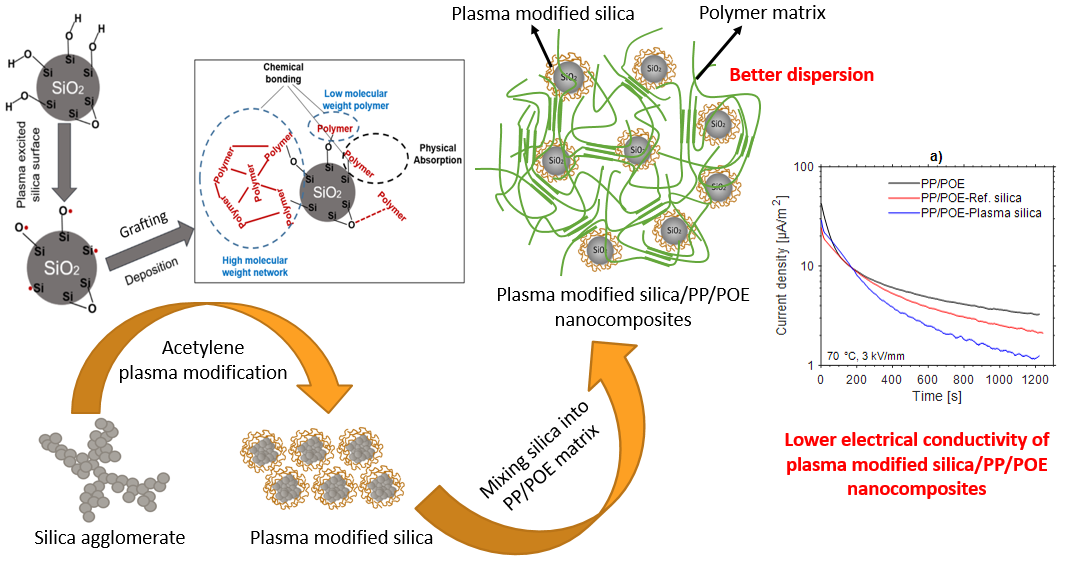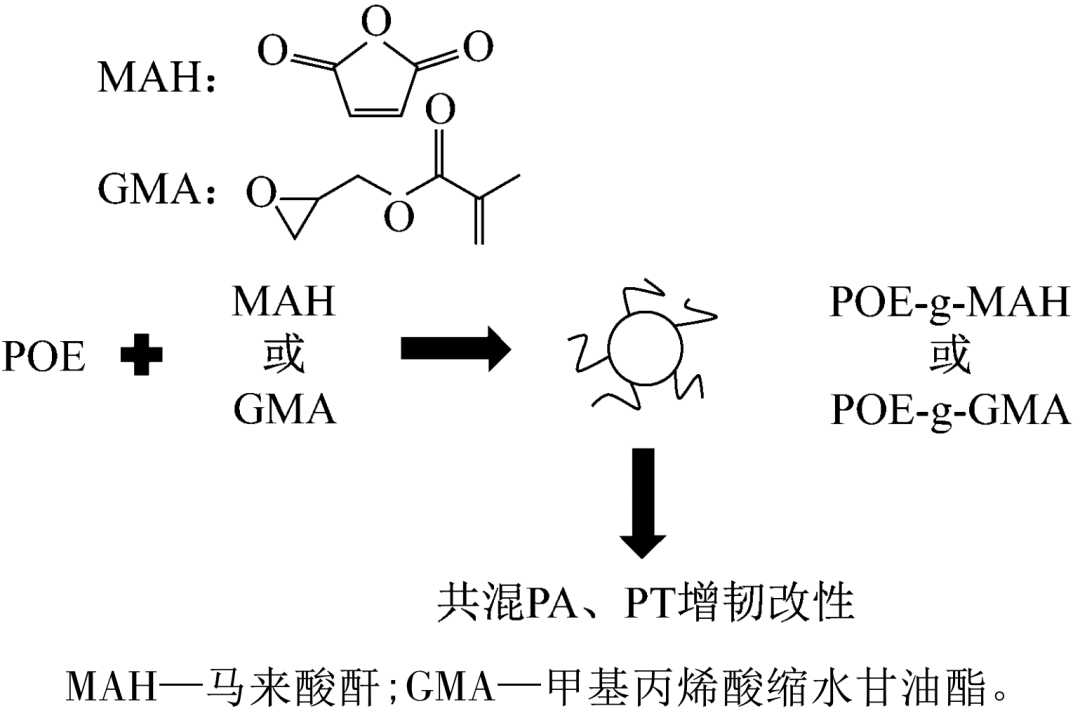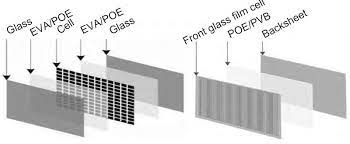POE is based on ethylene or propylene as the primary polymerization unit and comonomers polymerized copolymerized -olefins (mostly -olefins with 4 to 8 carbons, such as 1-butene, 1-hexene, and 1-octene).
The introduction of a certain amount of -olefin weakens the crystalline region of the carbon-carbon main chain, forming an amorphous region (rubber phase), which exhibits rubber elasticity. The crystalline region of the carbon-carbon main chain (resin phase) acts as a physical cross-linking point.
The macroscopic characteristics of the polymer are determined by its microstructure. In comparison to polymers made using conventional polymerization techniques, POE has excellent physical and mechanical properties (high elasticity, high strength, etc.), high elongation, and good low-temperature performance. On the other hand, the material’s narrow molecular weight distribution can make it less susceptible to deflection during injection molding and extrusion.
On the other hand, the POE molecular chain has good heat aging resistance and UV resistance since it is saturated and only includes a small number of tertiary carbon atoms.
POP and POE are not fundamentally different from one another, however there are differences in the copolymerized -olefin monomer concentration, and these differences directly affect the density between POE and POP. The density of POP is higher than that of POE because the mass fraction of POE comonomer is typically larger than 20% while the mass fraction of POP comonomer is less than 20%.
POP has great bonding strength, tear resistance, and transparency, and is mostly used in the field of film preparation. POE has outstanding weather resistance and aging resistance and is primarily utilized in the field of modification.
The special morphological structure of POE and POP endows them with special properties, making them widely used.
POE can be directly blended with modified PE and PP, or can be blended with modified polyester (PT) and polyamide (PA) after grafting, and can also be blended with ethylene-vinyl acetate (EVA) for foaming.
In addition, POE is also available as a single material.
However, POP is mainly used to prepare films after blending with PP.
Making use of POE
Application for POE direct modification
In order to mix PP and PE, POE direct modification is frequently employed (see Figure 1).
Application of POE direct modification in Figure 1.

The apparent viscosity of POE has a temperature sensitivity that is comparable to that of polyolefin resin, and POE has a low cohesive energy. It is simpler to get smaller particle size and narrower particle size dispersion after combining polyolefin. It is strengthened and resistant to impacts. The outcome is clear.
POE has been shown to be a more effective PP toughening agent. The “sea-island” structure that POE creates in the continuous phase of the PP in the PP/POE blend system can significantly increase the impact strength of PP at both low and normal temperatures.
Direct modification of POE PP is now the product’s most significant commercial use, namely for masks, shells, and car components.
The principal applications for POE directly modified PE are in the pipe and waterproof membrane industries.
High stiffness, inadequate impact resistance, and low hardness characterize PE. To fulfill the targeted performance criteria, it must be strengthened and changed by adding POE.
02. Application of POE graft modification
The application after POE grafting is mainly to toughen andmodify PAand polyester polymers (see Figure 2).

Strong polar groups like amide and ester linkages make form the primary chains of linear polymers like PA and PT. In addition to other qualities, this type of polymer offers high processability, mechanical characteristics, wear resistance, chemical resistance, and thermal stability. It is a significant engineering plastic and is utilized in many industries, including those of building, equipment, electronics, transportation, everyday needs, and others.
The impact characteristics of this kind of polymer can be improved by blending POE with PA and PT.
The compatibility is weak and the phase separation is severe when linear polymers with strong polar groups, such PA and PT, are combined with non-polar POE. The POE molecular chain is often grafted with polar polymers. monomers to increase the POE’s compatibility with these polymers.
The two primary types of POE-grafted polar monomers available today are MAH-grafted POE and GMA-grafted POE.
POE-grafted polar monomers currently mainly have two forms: MAH-grafted POE and GMA-grafted POE.
03 Foam modification application of POE
The foaming application of POE is mainly to modify EVA, and EVA is blended with POE foam to make the midsole of sports shoes (see Figure 3).

Figure 3 POE foam modification application
The essential component of sports shoes is the midsole. Its function is to deliver a relatively moderate foot sensation, stability, cushioning, and rebound, as well as to absorb the impact produced during exercise to give protection.
Due to its excellent rubber-like flexibility and softness, EVA is frequently utilized in the midsole of athletic shoes.
However, because EVA is more affordable (30% less expensive than POE), POE is more frequently employed as a modified version of EVA in the midsole of athletic shoes.
The product is lighter in quality, better in compression and rebound, pleasant to the touch, uniform and delicate in cell structure, and has a high tear strength after EVA mixed POE foaming.
03 POE is used as a single material
POE wird als Einzelsubstanz vor allem in Klebefolien für die Verpackung von Fotovoltaikmodulen verwendet.
To enclose and safeguard the solar cells in photovoltaic modules, an adhesive film is positioned between the tempered glass/backsheet of the module and the solar cells (see Figure 4).

Obwohl der absolute Wert der Folie bei den Komponenten nicht hoch ist, bestimmt ihre Qualität direkt die Produktqualität und die Lebensdauer der Module, da der Verpackungsprozess für Solarzellen irreversibel ist und die Lebensdauer der Module in der Regel mehr als 25 Jahre betragen muss. Sobald die Lichtdurchlässigkeit der Klebefolie abnimmt oder Fehler wie Vergilbung im Betrieb auftreten, werden die Solarzellen verschrottet und die Module unbrauchbar gemacht.
Derzeit sind POE-Folie und EVA-Folie die beiden am häufigsten verwendeten Arten von Verkapselungsfolien für Solarmodule. EVA-Klebefolie ist eine wärmehärtende Klebefolie, die eine schlechte Wetterbeständigkeit, eine hohe Wasserdampfdurchlässigkeit und eine geringe Festigkeit aufweist. Wasserdampf kann immer noch durch die Folie dringen, was die Folie zerstäubt und ihre Durchlässigkeit verändert. Außerdem zerfällt die EVA-Folie leicht und setzt Essigsäuremoleküle frei, die das Glas, die Rückwand und andere Komponenten angreifen und deren Lebensdauer verkürzen.
In den letzten Jahren wurde außerdem festgestellt, dass die EVA-Folie ein erhebliches Problem mit der potenzialinduzierten Degradation (PID) hat, was zu einer erheblichen Verringerung der Leistung des Kraftwerks führt.
Low water vapor transmission rate and high volume resistivity of POE film over EVA film ensure the safety and long-term aging resistance of photovoltaic modules in high temperature and high humidity environments, allowing for the modules’ long-lasting and effective use. Currently available POE films are prepared mostly by cross-linking POE with silane or peroxide.
crosslinking with peroxide
The POE molecular chain segment will be attacked by the newly generated free radicals, resulting in macromolecular free radicals, and there will be a gap between the two macromolecular free radicals when the temperature reaches the peroxide decomposition temperature. Additional cross-linking is produced; the POE molecular chain segment’s tertiary carbon atom’s hydrogen is particularly unstable, and the hydrogen in other secondary carbon atoms is the most susceptible to free radical assault, which is a place of active cross-linking (see Figure 5).

Crosslinking of silanes
Silane and POE are melt-grafted to create silane-grafted POE in the presence of a tiny quantity of peroxide. The silane-grafted POE then interacts with water in the presence of a catalyst to create a cross-linked structure of Si—O—Si.
Applications for POP goods
When compared to POE, POP has a smaller percentage of comonomers and a larger density. It resembles rubber in certain ways compared to polyolefin plastics but still possesses plastic’s strength and processability.
POP is easily processed, although it is sensitive to shear rate and the viscosity rapidly decreases at high shear rates. In the process of processing blown films, its static shear viscosity is high, melt strength is strong, and film bubble stability is good.
POP has exceptional co-extrusion qualities because of its outstanding heat sealing abilities and good compatibility with other resins. POP is primarily utilized in the field of film processing and integrated into because to the aforementioned qualities.
The US Food and Drug Administration (FDA) has authorized the majority of POP products, and they can be used right now in food packaging. The prepared film has higher thermal adhesion, excellent heat-sealing strength and film toughness, which enhances packaging reliability and integrity to prolong food shelf life. It is extruded from PP blended with POP at a lower heat-sealing temperature and at a faster packaging speed.
For medical and sanitary products as well as heavy packaging films, POP can also be used to produce flat extruded flower films, sealing layers, cast films, and blown films. For cold stretch casing film applications, POP can reduce film thickness by 10%, using fewer resources than conventional packaging materials.











